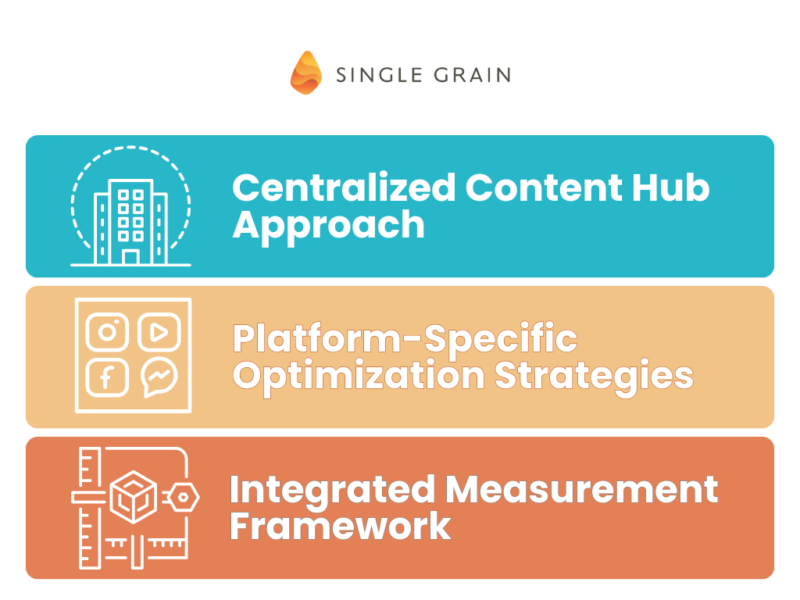Cross-Channel News Distribution: How to Maximize Reach and Engagement Across Platforms
A striking 86% of U.S. adults now get news from smartphones, computers, or tablets, according to recent Pew Research Center data. Yet despite this digital dominance, most news organizations still struggle to effectively distribute their content across the proliferating array of channels where their audiences spend time. The days of single-platform news consumption are long gone, replaced by an ecosystem where audiences expect seamless access to content whenever, wherever, and however they choose.
As platform fragmentation continues accelerating, cross-channel news distribution has evolved from a nice-to-have capability to a strategic imperative for media organizations seeking to maintain relevance and impact. This shift is evidenced by the 50% of news publishers who now consider cross-channel promotion equally important as SEO for driving traffic, according to a recent WAN-IFRA survey.
Key Takeaways
- Cross-channel news distribution has become a strategic necessity as 86% of U.S. adults now consume news on digital devices, with content viewership fragmented across numerous platforms rather than concentrated on publishers’ owned properties.
- Platform-specific optimization is crucial for effective distribution with each channel requiring tailored approaches—from visual, concise content for social media to personalized curation for email newsletters—while maintaining editorial consistency.
- A centralized content hub approach (“create once, publish everywhere”) allows news organizations to efficiently adapt content for multiple platforms while reducing duplicate efforts, ideally using headless CMS systems that separate content from presentation.
- Integrated measurement frameworks are essential to track performance across disparate platforms, with unified analytics systems expected to reduce manual data integration tasks by up to 30% by 2026.
- AI is transforming cross-channel news distribution by enabling real-time content optimization based on performance data, though 81% of publishers rank AI’s impact on search and referral traffic as a significant concern.
TABLE OF CONTENTS:
What Is Cross-Channel News Distribution?
Cross-channel news distribution refers to strategically disseminated news content across multiple platforms and touchpoints—from websites and mobile apps to social media, email newsletters, and emerging channels like voice assistants or connected TV. Unlike traditional single-channel approaches or disjointed multichannel efforts, true cross-channel distribution creates an integrated, cohesive experience for audiences while optimizing content for each platform’s unique characteristics.
The approach builds on cross-channel marketing principles but adapts them to the specific needs of news organizations, where timeliness, authenticity, and editorial consistency are paramount. At its core, this strategy is about meeting audiences where they are while maintaining editorial coherence across diverse environments.
Why Cross-Channel Distribution Matters Now
The fragmentation of news consumption has accelerated dramatically in recent years. Beyond the 86% of adults accessing news on digital devices, we’re seeing content viewership split across an ever-expanding universe of platforms. This is particularly evident in video consumption, where only 22% of online news video consumption happens on publisher websites, while a substantial 72% occurs via third-party platforms, according to the Reuters Institute Digital News Report.
This fragmentation presents both challenges and opportunities. News organizations that master cross-channel distribution can:
- Extend reach beyond their owned platforms
- Engage different audience segments where they naturally spend time
- Create multiple touchpoints throughout the audience journey
- Develop more sustainable business models through diversified traffic sources
- Build stronger audience relationships through consistent presence
Current Trends Driving Cross-Channel News Distribution
The Shift from SEO to Platform Diversification
Search engine optimization has long been the cornerstone of digital news distribution strategies. However, recent data signals a significant pivot: 50% of news publishers now consider cross-channel promotion as important as SEO for driving traffic, according to WAN-IFRA’s 2024 survey. This shift reflects growing concerns about dependence on single traffic sources and recognition that diverse channel strategies provide more resilience against algorithm changes.
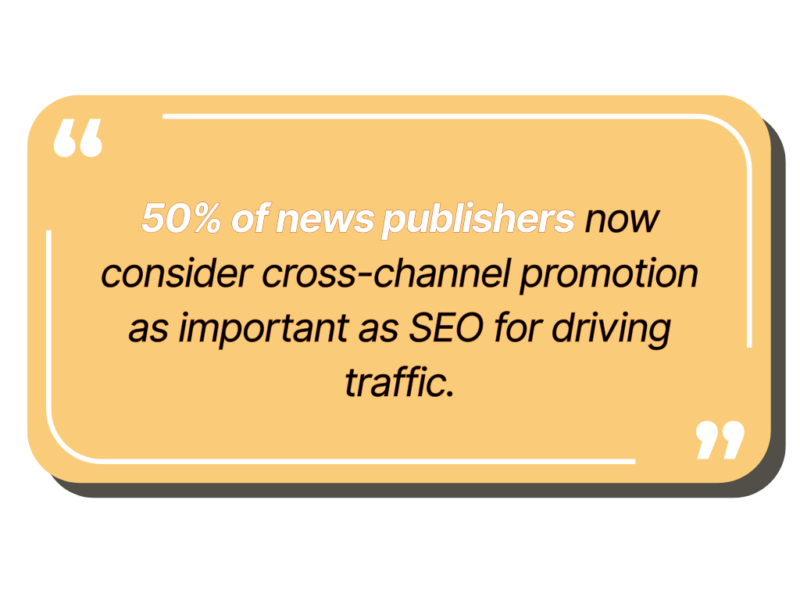
Mobile-First, Platform-Specific Content
The dominance of mobile devices has transformed how news organizations approach content creation and distribution. Rather than creating content for desktop and adapting it for mobile, leading newsrooms now develop mobile-first content that can be effectively distributed across channels. This approach recognizes that each platform has unique constraints and opportunities:
- Instagram and TikTok favor vertical, visually-driven storytelling
- Twitter/X rewards concise, timely updates with strong headlines
- LinkedIn values in-depth analysis and professional context
- Email newsletters benefit from personalized curation and direct audience relationships
Collaborative Cross-Channel Models
Resource constraints have accelerated collaborative approaches to cross-channel distribution. By pooling resources and expertise, news organizations can achieve greater impact across platforms than they could individually.
Case Study: The Conversation (US) in Collaboration with Local Newsrooms
Challenge: Local newsrooms faced persistent coverage gaps due to shrinking resources and limited staff, making it difficult to effectively cover critical community topics.
Solution: Launched the ‘The Conversation Local’ initiative, a collaborative journalism model partnering with local newsrooms and academic experts to produce in-depth content designed for multi-platform syndication.
Results: Each article was republished by an average of 20 additional publishers, dramatically increasing reach and engagement while effectively filling local coverage gaps.
Key Takeaway: Collaborative journalism across organizations can expand the reach of local news and drive deeper audience engagement.
Major Challenges in Cross-Channel News Distribution
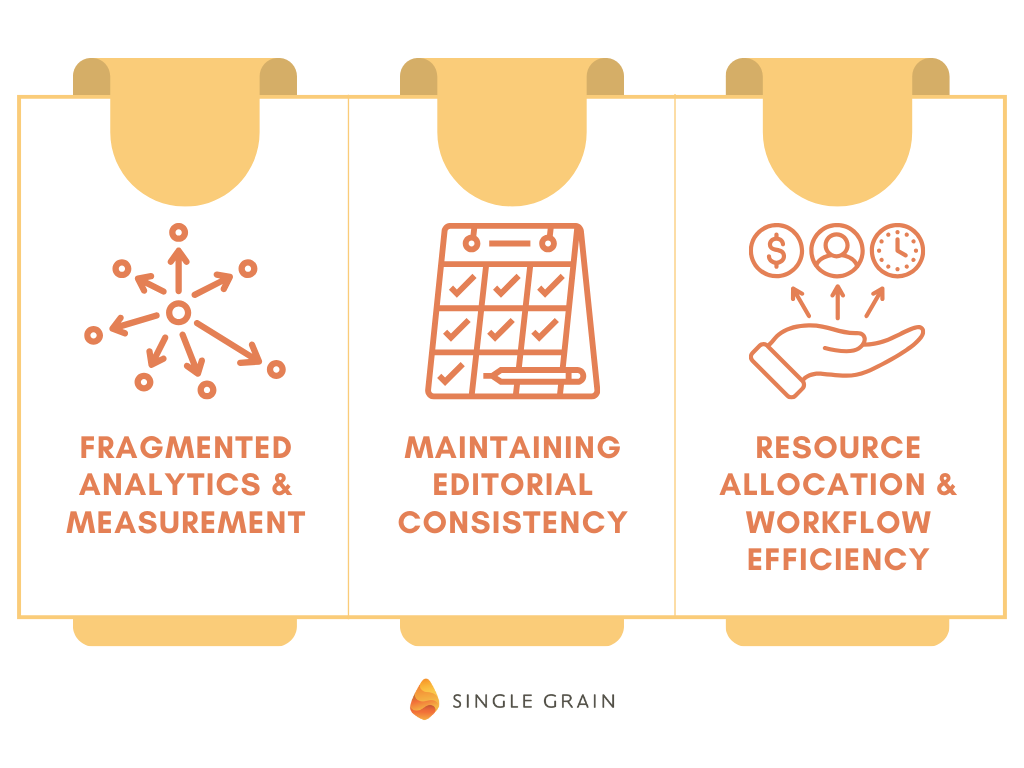
Fragmented Analytics and Measurement
One of the most significant obstacles to effective cross-channel distribution is the difficulty of measuring performance across disparate platforms. When analytics remain siloed, news organizations struggle to understand the complete audience journey and attribute value correctly. According to projections from INFORMS, there will be up to 30% reduction in manual data integration tasks by 2026 as organizations adopt integrated analytics systems—a clear recognition of the current inefficiencies.
Common measurement challenges include:
- Different metrics across platforms (views vs. engagement vs. conversions)
- Inconsistent attribution models
- Difficulty tracking cross-platform audience journeys
- Limited visibility into content performance on third-party platforms
Maintaining Editorial Consistency
As content is adapted for different platforms, maintaining a consistent voice, factual accuracy, and editorial standards becomes increasingly challenging. Video snippets on TikTok, in-depth articles on a website, and conversational formats in newsletters all require different approaches while still representing the same journalistic brand.
Resource Allocation and Workflow Efficiency
Producing platform-optimized content for multiple channels demands more resources than single-channel publishing. News organizations must determine how to efficiently create, adapt, and distribute content without duplicating efforts or stretching teams too thin.
Best Practices for Effective Cross-Channel News Distribution
Centralized Content Hub Approach
Leading news organizations are adopting a “create once, publish everywhere” (COPE) model built around centralized content hubs. This approach stores content in modular, channel-agnostic formats that can be efficiently adapted for different platforms.
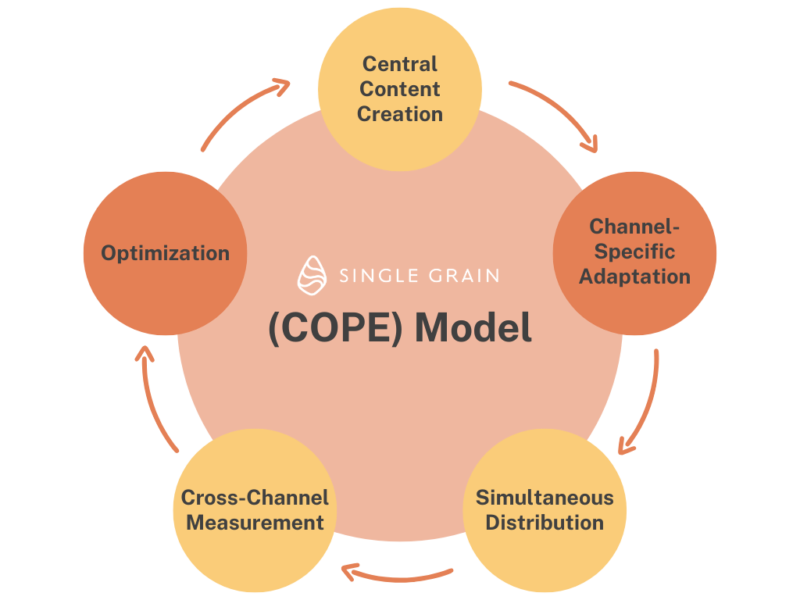
Key components of an effective content hub:
- Headless CMS systems that separate content from presentation
- Structured content models with modular components
- Centralized asset management for images, videos, and audio
- Automated transformation tools for different formats
- Unified tagging and metadata systems
Platform-Specific Optimization Strategies
While centralized content creation provides efficiency, successful cross-channel distribution requires thoughtful adaptation for each platform:
| Platform | Content Optimization | Distribution Strategy | Measurement Focus |
|---|---|---|---|
| Website | Long-form, multimedia integration | SEO, internal recirculation | Time on page, conversions |
| Social Media | Visual, concise, platform-native | Posting schedule, engagement triggers | Reach, engagement, referral traffic |
| Personalized, curated highlights | Segmentation, optimal timing | Open rates, click-through, retention | |
| Video Platforms | Platform-specific formats, optimized for auto-play | Platform algorithms, cross-promotion | Watch time, completion rates |
| Mobile Apps | Push notification strategy, offline functionality | User experience optimization | App opens, session duration |
Integrated Measurement Framework
Effective cross-channel distribution requires comprehensive measurement that connects dots across platforms. Leading news organizations develop integrated dashboards that provide:
- Cross-platform audience insights
- Content performance metrics standardized across channels
- Attribution models that account for multiple touchpoints
- Predictive analytics to guide future distribution decisions
Workflow Optimization for Cross-Channel Distribution
Streamlining workflows is essential for sustainable cross-channel distribution. According to industry forecasts, integrated analytics systems are expected to reduce manual data integration tasks by up to 30% by 2026. This efficiency enables teams to focus more on strategic content creation and less on repetitive formatting tasks.
Case Study: Improvado Media Analytics Implementation
- Challenge: Large media publishers struggled with inconsistent content performance data and inefficient workflows due to fragmented analytics across news distribution channels.
- Solution: Implemented a unified data taxonomy and centralized content performance data system, deploying real-time dashboards and dynamic attribution models to optimize headlines, story formats, and publishing timing.
- Results: Reduced reporting time by over 60%, improved cross-platform story alignment by 30%, and boosted multi-platform engagement rates by 22%, leading to an uplift in news consumption and ad revenue.
- Key Takeaway: Unified analytics and real-time tracking are key to streamlining newsroom workflows and maximizing cross-channel distribution effectiveness.
Effective workflow optimization strategies include:
- Role specialization – Designating channel experts who understand platform nuances while collaborating on central content
- Template development – Creating adaptable templates for common content types across channels
- Automation tools – Implementing tools that handle repetitive adaptation tasks
- Cross-functional teams – Organizing teams around content themes rather than channels
- Agile planning methods – Adopting flexible planning approaches that respond to real-time data
Technology Considerations for Cross-Channel News Distribution
The technological foundation supporting cross-channel distribution is evolving rapidly, with AI and integrated platforms taking center stage. These advancements come with both opportunities and challenges.
The AI Impact on Traffic and Metrics
The growing influence of AI on news consumption is creating measurement challenges for publishers. According to WAN-IFRA, 81% of publishers rank AI’s impact on search and referral traffic as a moderately significant concern, with 18% considering it very significant. AI-powered news aggregators, summarization tools, and search engines are changing how audiences discover and consume content, requiring adjustments to distribution strategies.
Multi-Platform Distribution Tools
Several technology solutions have emerged to streamline cross-channel distribution:
- Content Distribution Platforms – Tools like SocialFlow, Buffer, and Hootsuite that schedule and optimize content across social channels
- Headless CMS Systems – Platforms like Contentful and Contentstack that separate content creation from presentation
- Automated Content Adaptation – AI tools that reformat content for different channels
- Unified Analytics Dashboards – Solutions that integrate metrics across platforms
The right technology stack depends on organizational size, existing systems, and specific distribution needs. However, the trend is clearly toward integrated solutions that reduce manual interventions while maintaining editorial control.
Future Directions in Cross-Channel News Distribution

AI-Powered Content Optimization
The next frontier in cross-channel distribution involves AI tools that distribute and optimize content in real-time based on performance data. These systems can:
- Automatically adjust headlines and image selections based on platform-specific performance
- Recommend optimal distribution timing for different channels
- Generate channel-specific variations that maintain editorial integrity
- Predict content performance across platforms before publication
Emerging Platforms and Formats
The channel landscape continues to evolve, with several emerging platforms gaining importance in news distribution:
- Short-form video platforms – TikTok, Instagram Reels, and YouTube Shorts
- Audio formats – Podcasts, social audio, and voice assistant briefings
- AR/VR experiences – Immersive storytelling formats
- Messaging apps – Private distribution through WhatsApp, Telegram, and other messaging platforms
Successful news organizations maintain flexibility to experiment with these emerging channels while focusing resources on platforms that deliver meaningful audience and business results.
Building a Cross-Channel News Distribution Strategy
Assessment and Planning
Developing an effective cross-channel distribution strategy begins with an honest assessment of current capabilities and clear prioritization:
- Audience analysis – Where do your target audiences spend time? What platforms influence their news consumption?
- Channel audit – Evaluate performance across existing channels and identify gaps
- Resource assessment – Realistically assess team capabilities and technological resources
- Content inventory – Catalog existing content that could be repurposed across channels
- Prioritization framework – Develop criteria for channel investment decisions
Implementation Roadmap
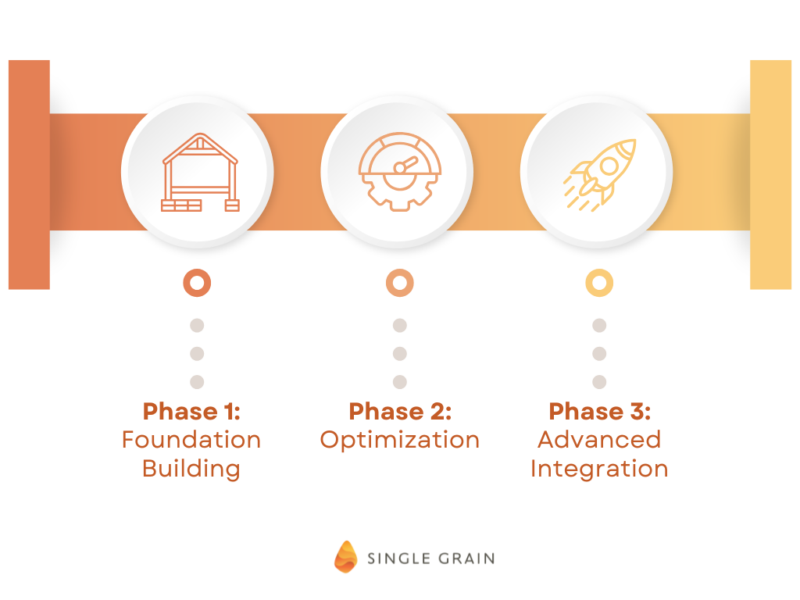
Successful cross-channel distribution typically follows a phased implementation:
Phase 1: Foundation Building
- Establish centralized content repository
- Develop basic templates for priority channels
- Implement cross-channel analytics tracking
Phase 2: Optimization
- Refine channel-specific content strategies
- Implement more sophisticated measurement
- Train teams on platform-specific best practices
Phase 3: Advanced Integration
- Deploy automation tools for content adaptation
- Implement predictive analytics
- Develop experimental approaches for emerging channels
Measuring Cross-Channel Distribution Success
Effective measurement frameworks look beyond channel-specific metrics to evaluate holistic performance:
- Reach expansion – Total unduplicated audience across channels
- Engagement depth – Quality of interactions across touchpoints
- Journey completion – Full funnel metrics from discovery to conversion
- Resource efficiency – Output and impact relative to investment
- Business outcomes – Revenue, subscriptions, or other key business metrics
Excelerate Your Cross-Channel News Distribution
Cross-channel news distribution has evolved from a technological challenge to a strategic imperative for media organizations. As audience fragmentation continues and new platforms emerge, the ability to efficiently create, adapt, and distribute content across channels will determine which news organizations thrive.
The most successful organizations balance centralized, efficient content creation with thoughtful platform optimization—maintaining editorial consistency while meeting audiences where they are. They invest in integrated technology and measurement systems that provide holistic views of performance while streamlining workflows.
By implementing the strategies outlined in this guide and continuously adapting to changing platform dynamics, news organizations can expand their reach, deepen audience engagement, and build more sustainable business models in an increasingly fragmented media landscape.
Looking to improve your cross-channel marketing strategies? Work with the leading digital marketing agency that specializes in integrated media approaches.
Related Video
The post Cross-Channel News Distribution: How to Maximize Reach and Engagement Across Platforms appeared first on Single Grain.
